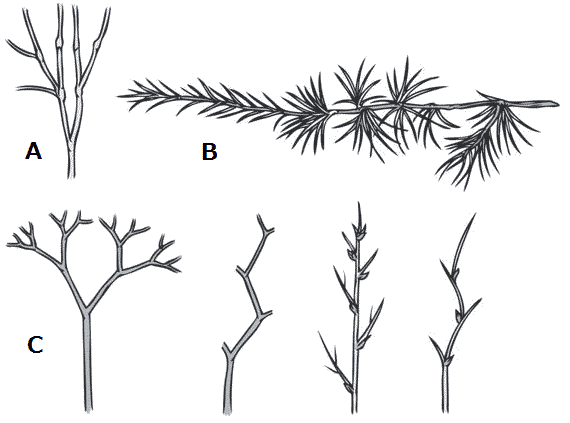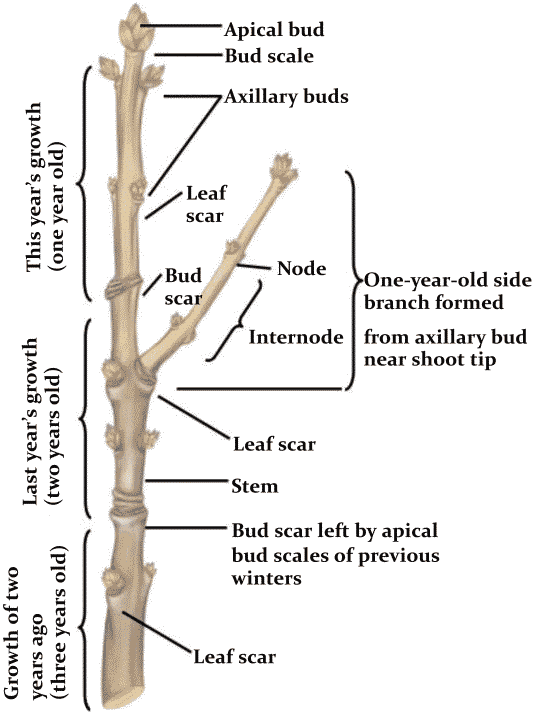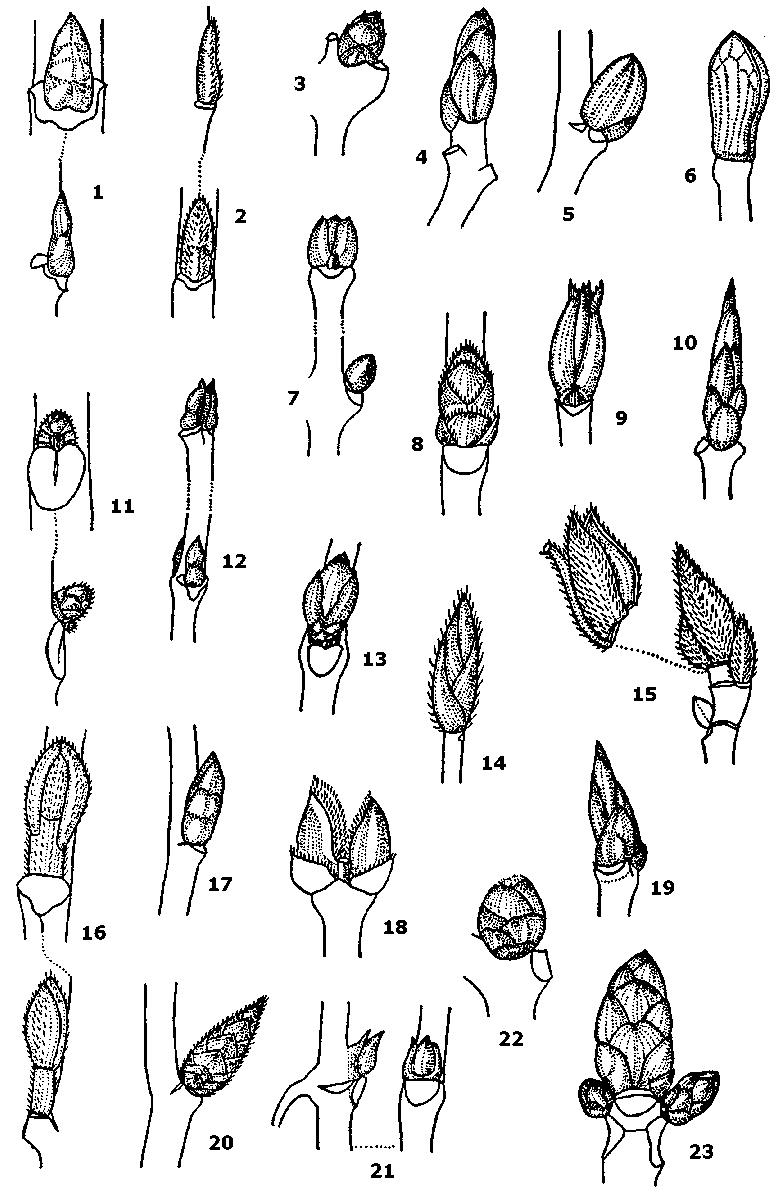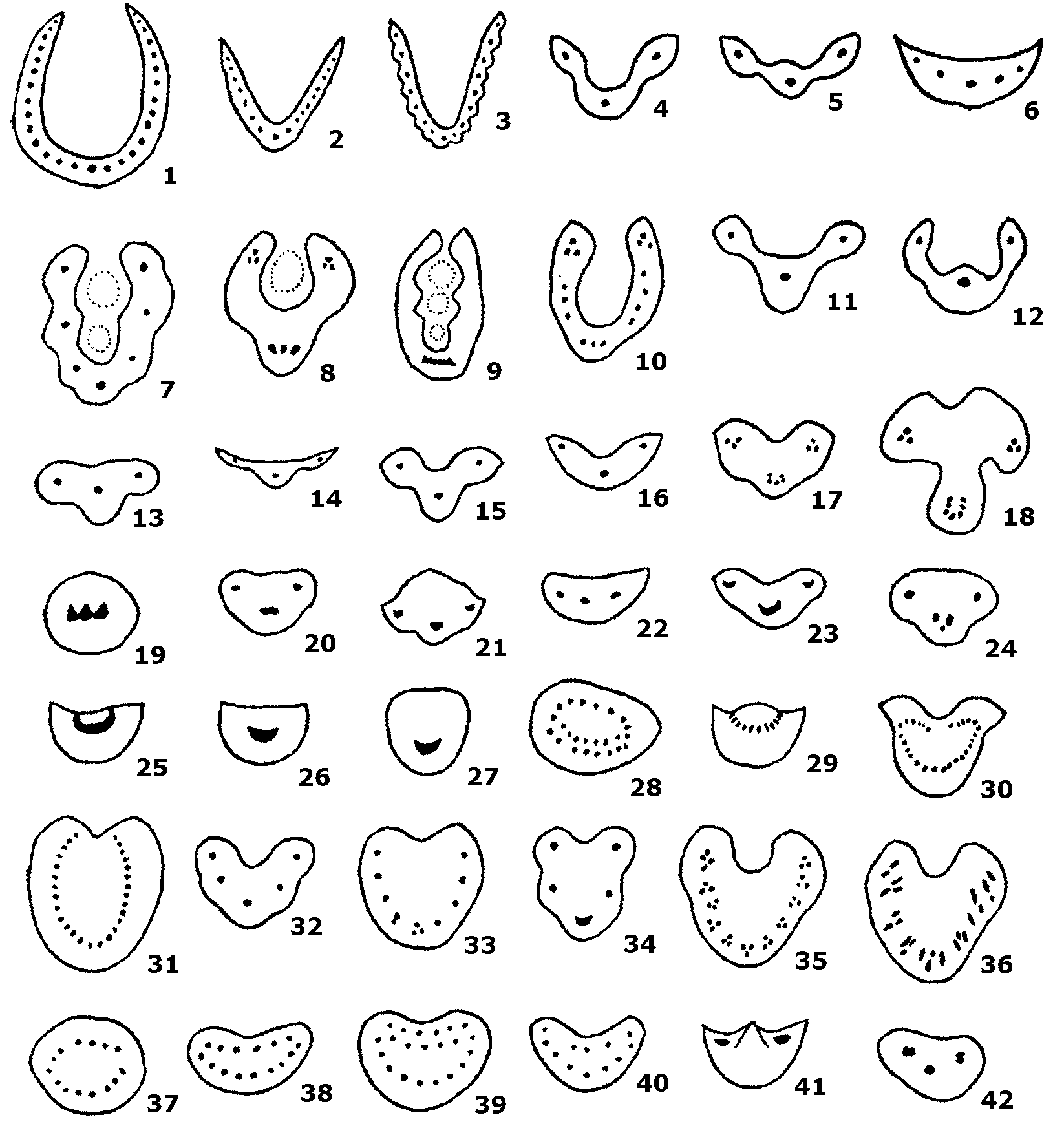(Upload on March 29 2025) [ 日本語 | English ]
Mount Usu / Sarobetsu post-mined peatland
From left: Crater basin in 1986 and 2006. Cottongrass / Daylily
HOME > Lecture catalog / Research summary > Glossary > Plant morphology > Shoot
|
Def. (シュート): the part of a vascular plant above the ground, consisting of stem and leaves (Hale & Margham 1991) ↔ root
Apical meristem on shoot apex(茎頂分裂組織)Def. shoot apex (茎頂): the tip of a shoot, which consists of the apical meristem and its surrounding tissues
playing a crucial role in the vertical growth of the plant and the formation of new organs Hofmeister, Wilhelm Friedrich Benedikt 1824-1877: 1856 apical cell theory Hanstein, Johannes Ludwig Emil Robert von 1822-1880: 1868 histogen theory Schmidt, Adolf: 1924 tunica-corpus theory |
[plant morphology (植物形態)] Shoot types (on woody plants) (長枝と短枝)Long shoot (長枝): elongated, long nodeShort shoot, spur shoot or fruit spur (短枝)  on Japanese larch (Larix kaempferi) (Ref. Seasonal heterophylly)  A: shoot with long internodes and well developed nodes. B: long shoot and dwarf shoots of Larix. C: ramification of shoot: dichotomic, overtopping, monopodial, sympodial (from left to right). |
|
Def. embryo (胚): a young, developing plant contained within a seed containing the essential components that are used for the growth Key parts of embryo: cotyledons + radicle + hypocotyl + plumuleCotyledons (子葉): the first leaf or one of the first pair of leaves, emerging from the embryo of a seed plant during germination Radicle (胚軸): the embryonic root of a plant, which is the first part of a seedling to emerge from the seed during seed germination |
Epicotyl (上胚軸): the region of a seedling embryo that lies above the cotyledons and below the first true leaves
|
|
Node (節): holding buds Internode (節間): the portion of an axis intermdeiate between two nodes
Leaf trace gap (葉跡隙): referring to the strand or bundle of vascular tissue (xylem and phloem) that extends from the vascular system in the stem into the leaf through a gap in the stem vascular cylinder Aerial stem or aboveground stem (地上茎)so-called stemStolon (匍匐枝) ≈ creeper (匍匐茎): a horizontal stem (often called a runner) that grows along or just below the soil surface, producing roots and shoots at its node Def. Subterranean stem or underground stem (地下茎, s.l.): any stem that grows underground
= rhizomes, s.s. + tubers + corms + stem-derived bulbs + stolons running below th ground surface + … |
Def. Rhizome (地下茎(根系), s.s.): a modified stem growing horizontally underground
Primary rhizome: primarily developing for underground stems
⇔ Root tuber (storage root, 塊根), originating from roots, not from stems Climbing plant (つる植物)Vineherbaceous, relatively thin-stemmed climber (s.s.)Liana (liane)woody climbertwiner: twining by the stems Ex. Pueraria lobata climber
tendril climber: tendril or hook Ex. Galium spurium |
Branch (枝) |
|
|---|---|
Fig. Branch of woody plants apical bud = terminal bud bud scale axillary bud leaf scar bud scar node internode |
Def. branch: a secondary stem or limb, growing out from the main stem or trunk
supporting leaves, flowers and fruits, i.e., growth and reproduction Primary branch (一次枝): a major branch growing directly from the main stem or trunksupporting the overall structure and growth of plants, by bearing leaves, flowers and fruits and serving as conduits for transporting nutrients and water Secondary branch (二次枝): growing out from a primary branchextending the leaf surface area allowing it to capture more solar energy, bearing additional leaves, flowers and fruits contributing to the overall growth and reproduction Adventitious branch (不定枝): emerging from an unexpected location, e.g., from stems, leaves or roots rather than from the usual nodesdeveloping in response to environmental stress, damage or as part of vegetative reproduction - important for plant adaptation and survival Branching (分枝)Def. the process by which plants develop new shoots from existing stems, resulting in the formation of branchesdetermining the growth and reproduction, as it allows them to expand their leaf area, capture more solar energy and produce more flowers and fruits a. Dichotomous branching (二叉分枝)b. Monopodial branching (単軸分枝) or lateral branching (側方分枝) |
|
≡ A small lateral or terminal protuberance on the stem of a plant that may develop into a flower, leaf, or shoot
Def. Axil (葉腋): the upper angle between a leaf or branch and the stem from which it arises |
Def. Axillary bud (腋芽): an embryonic shoot that develops in the axil (and has the potential to grow into a lateral branch, flower or inflorescence) |
A dormant plant bud enclosed in a protective covering which enables it to survive during the winter ⊂ dormant budApplication to tree taxonomy (冬芽による樹木分類)(a) Attached part (つき方), (b) morphology, (c) leaf scar (葉痕) (a) Attached part of winter bud(b) Morphology of winter buds (冬芽形態) Winter buds of major species in Hokkaido (北海道主要樹種の冬芽). Sizes, uneven (サイズ不同) (斎藤 2009) 1; Salix cardiophylla Trautv. et C. A. Mey. var. urbaniana (Seemen) Kudo) オオバヤナギ, 2: Salix schwerinii E. L. Wolf エゾノキヌヤナギ, 3: Syringa reticulata (Bl.) H. Hara ハシドイ, 4: Cornus controversa Hemsl. ex Prain ミズキ, 5: Tilia japonica (Miq.) Simonkai シナノキ, 6: Liriodendron tulipifera L. ユリノキ, 7: Fraxinus lanuginosa Koidz. f. serrata (Nakai) Murata) アオダモ, 8: Euonymus sieboldianus Bl. マユミ, 9: Hydrangea petiolaris Sieb. et Zucc. ツルアジサイ, 10: Euonymus oxyphyllus Miq. ツリバナ, 11: Paulownia tomentosa (Thunb.) Steud. キリ, 12: Viburnum opulus L. var. calvescens (Rehder) Hara カンボク, 13: Sambucus racemosa L. ssp. kamtschatica (E. L. Wolf) Hultén エゾニワトコ, 14: Lindera umbellata Thunb. var. membranacea (Maxim.) Momiy. ex H. Hara et M. Mizush. オオバクロモジ, 15: Magnolia denudata Desr. ハクモクレン, 16: Alnus hirsuta Turcz. ケヤマハンノキ, 17: Betula maximowicziana Regel ウダイカンバ, 18: Acer japonicum Thunb. ハウチワカエデ, 19: Sorbus commixta Hedl. ナナカマド, 20: Carpinus cordata Bl. サワシバ, 21: Vitis coignetiae Pulliat. ヤマブドウ, 22: Celastrus orbiculatus Thunb. ツルウメモドキ, 23: Aesculus turbinata Bl. トチノキ Leaf scar or leaf trace (葉痕)the mark left by a leaf after defoliation from the twig or branch |
 wb: winter bud, st: stiple trace, vbt: vascular bundle trace, lt: leaf trace. 1: circular, 2: cordate, 3: reniform, 4: flat-circular, 5: half-round, 6: linear, 7: crescent, 8: V-shaped, 9: U-shaped, 10: Y-shaped, 11: oblong, 12: pentagonal, 13: triangular, 14: reverse-pine-shaped (tentative translation), 15: T-shaped, 16: O-shaped (horse-shoe), 17: cocoon-shaped  Leaf traces on major trees in Hokkaido. Sizes, not adjusted. (主な樹種の葉痕, サイズ不同) (Saito 2009) 1. Aralia elata (Miq.) Seem. (タラノキ), 2. Acanthopanax sciadophylloides Franch. et Sav. (コシアブラ), 3. Kalopanax pictus (Thunb.) Nakai (ハリギリ), 4. Acer mono Maxim. (イタヤカエデ), 5. Hydrangea paniculata Sieb. et Zucc. (ノリウツギ), 6. Sorbus commixta Hedl. (ナナカマド), 7. Alangium platanifolium (Sieb. et Zucc.) Harms var. trilobatum (Miq.) Ohwi (ウリノキ), 8. Phellodendron amurense Rupr. (キハダ), 9. Styrax obassia Sieb. et Zucc. (ハクウンボク), 10. Rhus javanica L. var. roxburghii (DC.) Rehd. et Wils. (ヌルデ), 11. Viburnum opulus L. var. calvescens (Rehder) Hara (カンボク), 12. Salix cardiophylla Trautv. et C. A. Mey. var. urbaniana (Seemen) Kudo (オオバヤナギ), 13. Populus maximowiczii A. Henry (ドロノキ), 14. Hydrangea petiolaris Sieb. et Zucc. (ツルアジサイ), 15. Schizophragma hydrangeoides Sieb. et Zucc. (イワガラミ), 16. Cercidiphyllum japonicum Sieb. et Zucc. ex Hoffm. et Schult. (カツラ), 17. Pterocarya rhoifolia Sieb. et Zucc. (サワグルミ), 18. Juglans mandshurica Maxim. var. sieboldiana (Maxim.) Makino (オニグルミ), 19. Schisandra chinensis (Turcz.) Baill. (チョウセンゴミシ), 20. Ulmus davidiana Planch. var. japonica (Rehder) Nakai (ハルニレ), 21. Acer japonicum Thunb. (ハウチワカエデ), 22. Carpinus cordata Bl. (サワシバ), 23. Betula maximowicziana Regel (ウダイカンバ), 24. Alnus hirsuta Turcz. (ケヤマハンノキ), 25. Euonymus sieboldianus Bl. (マユミ), 26. Celastrus orbiculatus Thunb. (ツルウメモドキ), 27. Actinidia arguta (Sieb. et Zucc.) Planch. ex Miq. (コクワ), 28. Morus bombycis Koidz. (ヤマグワ), 29. Syringa reticulata (Bl.) H. Hara (ハシドイ), 30. Fraxinus mandshurica Rupr. (ヤチダモ), 31. Paulownia tomentosa (Thunb.) Steud. (キリ), 32. Sambucus racemosa L. ssp. kamtschatica (E. L. Wolf) Hultén (エゾニワトコ), 33. Aesculus turbinata Bl. (トチノキ), 34. Picrasma quassioides (D. Don) Benn. (ニガキ), 35. Ailanthus altissima (Miller) Swingle (シンジュ), 36. Rhus trichocarpa Miq. (ヤマウルシ), 37. Parthenocissus tricuspidata (Sieb. et Zucc.) Planch. (ツタ), 38. Tilia japonica (Miq.) Simonkai (シナノキ), 39. Magnolia obovata Thunb. (ホオノキ), 40. Quercus mongolica Fisch. ex Ledeb. var. grosseserrata Rehd. Wils. (ミズナラ), 41. Maackia amurensis Rupr. et Maxim. (イヌエンジュ), 42. Staphylea bumalda DC. (ミツバウツギ) |
1) Verticil (輪生葉序)= verticillate phyllotaxis (whorled phyllotaxis)Opposite, decussate or superposed phyllotaxis (対生葉序): one of the verticillate phyllotaxes 2) Alternate phyllotaxis (互生葉序)3) Specific phyllotaxis (特殊型) |
Foliage (葉群): a mass noun that refers to leaves as a feature of plants.
Plant leaves, especially tree leaves, considered as a group |